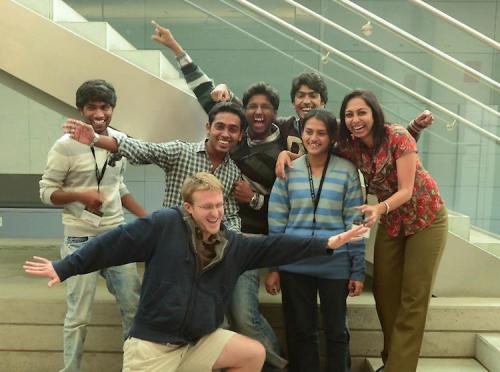NCBS, IIT-Guwahati students win silver at BIOMOD 2012, Harvard
It's on at 4 pm, in Safeda. The world ends at ~4.20 pm - come and attend your last scientific talk!!! The speakers are a bunch of young undergraduates, do encourage them with your presence and toughen them with your best questions. See you there at 4 pm on Friday.
You can watch an entertaining video - particularly for fans of Batman! - about their project via the video-hosting site Vimeo - just click here.
And read the abstract from the competition below:
Chemically triggered release of molecular cargo encapsulated within the DNA icosahedron
Anusuya Banerjee, Anand Saminathan, Shaunak Kar, T. Harshavardhan Reddy, Bharath Raj, Bharath Anand and Dhiraj Bhatia.
The unique properties of DNA such as its persistence length and specific associations enabled by Watson Crick base pairing have helped it emerge as a powerful substrate for nanoconstruction. Three dimensional polyhedra based on DNA are emerging as strong candidates for display and delivery of various biomolecules in living systems. However, achieving controlled release of encapsulated cargo with spatial and temporal control aided by molecular cues remains a challenge. Here we show the controlled opening of a complex DNA polyhedron i.e. the icosahedron, in response to an external molecular trigger, namely cyclic-di-GMP (c-di-GMP). The icosahedron is engineered with aptamers for c-di-GMP that act as locks for the icosahedral cage. In the presence of c-di-GMP, these aptamer locks remodel due to tertiary structure formation that results the dissociation of the icosahedron into its two contitutent halves due to strand displacement. This releases encapsulated internal cargo, such as fluorescent dextran. Using various fluorescence methods such as quenching and FRET, we elucidate tight control over opening of the DNA icosahedron. This suggests that cargo-loaded polyhedra can be integrated with naturally occurring pathways and their specifically secreted molecular cues that in turn provide spatial and/or temporal control over cargo release in diverse contexts.
To access the BIOMOD site - click here.



Comments
Post new comment